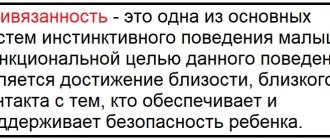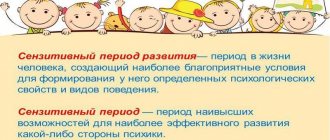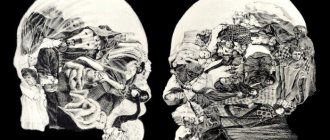Games and exercises aimed at correcting children's fears
Children's fears and ways to correct them in preschool children
Author: Shchipitsina Marina Ivanovna, educational psychologist, MBDOU "Savinsky kindergarten", Savino village, Perm region, Karagay district. Description of material: I bring to your attention games selected for parents to correct children's fears. As a rule, the correction of fears is carried out to a greater extent by parents, so parents need to try different methods of working with their child’s fears. The material will be useful to parents of preschool children, teachers and psychologists of preschool educational institutions. Goal – Relieving fears in children Objectives: 1. Develop social trust. 2. Develop inner freedom and looseness. 3. Help in overcoming negative experiences. Fear is a mental state associated with a pronounced manifestation of asthenic feelings (anxiety, restlessness, etc.) in situations of threat to the biological or social existence of an individual and aimed at the source of real or imaginary danger. Children's fears are a thoroughly researched topic by psychologists, doctors, and teachers, but not fully studied. Children are afraid of injections and dragons, dogs and the giant who lives under the bed, loud sounds and moths... Causes of children's fears: a multi-traumatic situation, authoritarian behavior of parents, impressionability, suggestibility, stress, illness.
Children often develop situational fears due to unexpected touching, too loud a sound, falling, etc. The fact that a child is experiencing fear is evidenced by the following: - does not fall asleep alone, does not allow the light to be turned off; - often covers ears with palms; - hides in a corner, behind a closet; - refuses to participate in outdoor games; - doesn’t let mom go; - sleeps restlessly, screams in his sleep; - often asks to be held; - does not want to meet and play with other children; - refuses to communicate with unfamiliar adults who come to the house; - categorically refuses to accept unfamiliar food. Verbal and artistic exercises
1.Draw your fear. The child is asked to draw his fear on an A4 sheet of paper. When the drawing is ready, ask: “What do we do now with this fear?” 2. We come up with a fairy tale. Together with your children, compose a fairy tale about a magic chest that contains something that conquers all fears. What could it be? Have the children draw it. 3. We come up with and draw a friend. Ask your child: “Who do you think is not afraid of anyone or anything?” When the child answers, add: “Let's try to draw him (her).” 4. Rainbow of power. Draw a rainbow on a sheet of watercolor paper and separate small pieces from pieces of plasticine (the primary colors of the spectrum). Invite your child to smear the pieces, repeating out loud: “I am brave,” “I am strong.” “I am brave” - the children repeat, smearing the plasticine with their right hand; “I am strong” - smearing plasticine with his left hand. 5. Where does fear live? Offer your child several boxes of different sizes and say: “Please make a house for fear and close it tightly.” 6. Let's scare fear. Invite your child to listen and repeat the poem after you: Fear is afraid of sunlight, Fear is afraid of a flying rocket, Fear is afraid of cheerful people, Fear is afraid of interesting things! I will smile, and fear will disappear, It will never find me again, Fear will get scared and tremble, And it will run away from me forever! The child repeats each line, smiles and claps his hands. 7. Throw out fear. Children roll a ball out of plasticine, saying: “I’m throwing away fear.” The ball is then thrown into the trash bin. 8. If I were big. Invite your child to imagine that he has grown up. “How will you drive away fear in children when you yourself become an adult?” 9. Letting go of fear. Inflate the balloons and give them to the child. Releasing the ball into the sky, repeat; “Balloon, fly away, take your fear with you.” While the ball flies away, repeat the poem. 10. I will feed my fear. Invite your child to listen and repeat after you the poem one line at a time: Fear is afraid of sunlight, I’ll take three kilograms of buns, Sweets, cakes and cheesecakes, Cookies, chocolate, Jam, marmalade. Lemonade and kefir, And cocoa, and marshmallows, Peaches and oranges, And I'll add blue ink. Fear will eat it all up and behold, his stomach hurts. Fear's cheeks puffed up, fear shattered into pieces. When the child repeats the poem, ask him to draw a picture for it, 11. Burying the fear. Prepare boxes of sand and one large empty box. Make several flat circles out of clay. Ask your child: “What will this fear be called?” (Fear of the dark, fear of noise, fear, “they won’t take me out of the garden,” etc.). After receiving the answer, offer to shackle the fear. When all the fears are buried, place the boxes in a large box and invite the child to draw a guard who will not let the fears out of the box. The box must be hidden in a closet and locked with a key. 12. Magic wand. Attach a ball of plasticine to the tip of a pencil, coat the pencil with glue, and wrap it in tinsel (rain, foil). Attach beads and seed beads to the plasticine ball. Put the wand down for 5 minutes to “gain the magic.” Learn a “spell” against fear: I can do anything, I’m not afraid of anything, Lion, crocodile, darkness - so be it! The magic wand helps me, I am the bravest, I know it! Repeat the “spell” 3 times, circle the “magic wand” around yourself. 13. Finger puppet theater. Act out scenes in which one of the dolls is afraid of everything, and the others help her cope with her fear. You should ask children what options for dealing with fear they can offer, encourage them, and come up with as many options as possible. 14. Let's trample fear. Spread three sheets of Whatman paper on the floor. Pour boys' paints into plastic plates. Invite your child to step into the paint and walk through whatman paper with words; “Now I’ll trample on fear, I want to become brave!” 15. Invite your child to listen and repeat the poem after you: Shout exercise: I clap (clap my hands), I stomp (sink my feet), I growl loudly (pronounce “r-r-r”), I drive away fear (wave my arms) 16. Let's make up a horror story. You start the story, and the child adds one sentence at a time. For example: “It was a terrible night... A big dog came out for a walk... She wanted to bite someone...”, etc. The parent should end the horror story funny; “Suddenly a large bowl of ice cream came down from the sky. The dog wagged its tail, and everyone saw that it was not at all angry, and they gave it a lick of ice cream.” 17. We write to the wizard Dobrosil. Draw your fear and write: “Wizard Dobrosil, turn my fear into... (globe, candy, rainbow, dragonfly...). Seal letters in envelopes. Bring the child the answer. 18. We are brave and friendly. Children stand in a circle, holding hands, and repeat the poem line by line after the psychologist, raising their hands up at the end of each line.
I'm not afraid of anything with my friend. Neither darkness, nor a wolf, nor a blizzard, nor vaccinations, nor a dog, nor a bully boy. Together with a friend I am stronger, Together with a friend I am braver. We will protect each other and conquer all fears! Theatrical sketches.
An improvised screen can be made from 2 chairs and a blanket, the characters are toys.
19. Sketch of a terrible dream. A boy or girl goes to bed, and suddenly... something scary appears in a dark corner (providence, wolf, witch, robot - it is advisable for your child to name the character himself). The “monster” must be portrayed as funny as possible. The child doll is afraid, trembles (all emotions should be greatly exaggerated), and then he himself or with the help of the mother doll turns on the light. And then it turns out that the terrible monster is just a curtain fluttering in the wind, or clothes thrown on a chair, or a flower pot on the window... 20. Sketch of a Thunderstorm The thing happens in a country house or in a village. The doll child goes to bed and is just falling asleep when suddenly a thunderstorm begins. Thunder rumbles, lightning flashes. Thunder is not difficult to convey, and lightning does not have to be shown, just saying it is enough. By the way, speaking (and not just demonstrating events and actions on a screen) in therapeutic sketches is extremely important. The child-doll is shaking in horror, chattering his teeth, maybe crying. And then he hears someone whining pitifully and scratching at the door. This is a small, chilled and frightened puppy. He wants to enter a warm house, but the door just won’t budge. The “child” feels sorry for the puppy, but on the other hand, it’s scary to open the door to the street. For some time these two feelings fight in his soul, then compassion wins. He lets the puppy in, calms him down, takes him to his crib, and the puppy peacefully falls asleep. In this sketch, it is important to emphasize that the “child” feels like a noble defender of the weak. It is advisable to find a small toy dog so that it is noticeably smaller than a child doll. You can act out these and similar scenes with your child, and if he refuses at first, make him a spectator. The best thing is when adults become the audience, and the child is the only “actor” playing different roles in turn. 21. Sketch based on a scene from the cartoon “A Kitten Named Woof.” Invite your child to “go” to the cartoon “A Kitten Named Woof.” A kitten climbed into the attic during a thunderstorm and sits there alone, trembling with fear. Everything around is roaring, but he doesn’t run away and even invites his friend, the puppy Sharik, to be afraid together. Discuss the characters' actions and then act out the scene. 22. Game “Bee in the Dark” “The bee flew from flower to flower (chairs of different heights, cabinets, etc. are used). When the bee flew to the most beautiful flower with large petals, she ate nectar, drank dew and fell asleep inside the flower (a table is used that a child climbs under). Night fell imperceptibly, and the petals began to close (the table is covered with cloth). The bee woke up, opened her eyes and saw that it was dark around. She remembered that she remained inside the flower and decided to sleep until the morning. The sun rose, morning came (the matter is removed), and the bee began to have fun again, flying from flower to flower.” The game can be repeated, increasing the density of matter, that is, the degree of darkness. 23. Exercise “Swing”. The child sits in the “fetal” position: he raises his knees and lowers his head to them, his feet are firmly pressed to the floor, his hands are clasped around his knees, his eyes are closed. The adult stands behind him, puts his hands on the child’s shoulders and carefully begins to slowly rock him. The child should not “cling” with his feet to the floor and open his eyes. You can wear a blindfold. The rhythm is slow, the movements are smooth. Perform the exercise for 2 - 3 minutes. 24. “Tumbler” (for children from 6 years old). Two adults stand at a distance of a meter, facing each other, with their hands out in front. Between them stands a child with his eyes closed or blindfolded. He is given the command: “Don’t take your feet off the floor and feel free to fall back!” The outstretched arms catch the falling person and direct the fall forward, where the child is again met by the outstretched arms of an adult. This swaying continues for 2 - 3 minutes, while the amplitude of the swaying may increase. Children with severe fears perform the exercise with their eyes open, the amplitude of the swing is minimal at first. 25. Game “In a Dark Hole” In the room where the child is, as if by mistake, turn off the light for 3 to 5 minutes. Invite your child to imagine that he is in a mole's hole. A firefly hurries to visit him with his magic lantern. A child who is afraid of the dark is chosen to play the role of the firefly. "Firefly" with the help of his magic lantern (use any pre-prepared lantern) helps children reach the illuminated place. 26. Game “Shadow” Calm music sounds.
The children are divided into pairs: one child is the “traveler”, the other is his “shadow”. The “Shadow” tries to accurately copy the movements of the “traveler” who walks around the room, makes various movements, unexpectedly turns, crouches, bends down to “pick a flower,” pick up a “beautiful pebble,” nods his head, jumps on one leg, etc. Bibliography
1. Aralova M.A. Directory of a preschool educational institution psychologist. – M.: 2007 2. Sazanova N.P. Novikova N.V. Overcoming aggressive behavior of older preschoolers in kindergarten and family. - St. Petersburg: 2010 3. Working with parents: practical recommendations and consultations on raising children 2-7 years old - Volgograd - 2009
We recommend watching:
Children's fears and how to deal with them. Do-it-yourself didactic game for children 2-6 years old. Felt mosaic Games with an eraser for children 3-6 years old Do-it-yourself multifunctional teaching aid for kindergarten. Miracle cube
Similar articles:
Childhood fears
If a child is afraid of something. What to do?
Tips for parents
Parents' help in overcoming their anxiety lies not only in moral support for their child, but also in preparing his personality for social life. It is important to teach him a certain culture of behavior and interaction with others. The fact is that psychology is a versatile science, and all parents who want to raise a mentally healthy child should know its “basics”. Therefore, it is important for every mother and father to take advantage of the following advice from psychologists:
- It will be easier to deal with social fears if a teenager learns to make eye contact with people. Parents should remind their children of this more often, involving them in contact at home. It will be easier for the child to find contact with people in the future.
- The different options for starting and ending a conversation should be explained. Systematic training (even in the form of a game), with greetings and farewells, will make the child more relaxed.
- All conditions should be created for the child to have friends. Any unobtrusive help will be useful.
Psychologists also advise changing your attitude towards children.
Most often, parents are very demanding of teenagers and try to control their every step or action. The fact is that such care has a negative effect on the young psyche.
A teenager may feel insecure due to the lack of the right to vote, the right to his own opinion and privacy.
Fear depending on the child's age
- Children under one year of age are normally afraid of loud sounds, sudden movements, strangers, etc.
- Between the ages of 1 and 3 years, fear of separation from parents or parental rejection appears. Children are afraid of nightmares, injuries, unfamiliar peers and natural phenomena.
- From 3 to 5 years old, children begin to realize the finitude of life and experience fear about their own death or the death of relatives. They are frightened by terrible dreams, fire and fires, poisonous snakes and natural elements.
- At the age of 6-8 years, there is a fear of sinister creatures (ghosts, witches), fear of loneliness, physical violence and social “school” fears (being unsuccessful, not meeting the expectations of parents, being rejected by the team).
- At the age of 8-11, there is a fear that the child’s bad deeds will be noticed by others. Children are afraid of illnesses, school failures, robbers, thieves and hooligans, spinning (some carousels), heights and quarrels with parents.
- From 11 to 13 years of age, children are afraid of possible unattractiveness, their own strange actions, serious illness or death, sexual abuse, criticism from adults, the possibility of getting into a stupid situation and the loss of personal belongings.
How to tell if a child is afraid of something
To overcome childhood fear, you first need to identify it. It is most reasonable to do this during a confidential conversation with the child. You can directly ask him if there are things that are bothering him. This is advisable after the child reaches the age of three years.
Mom or dad should gently and slowly ask the child about any concerns. Do not focus on any individual possible childhood fears - this can lead to suggestion and fixation. When talking to your baby, encourage him and praise him. Having discovered a child’s fear, demonstrate calmness and confidence, because the child will definitely analyze your state and emotions. If he understands that his fears cause any anxious feelings in an adult, then he may begin to worry even more. Let the child describe his fear, tell him what it looks like, what feelings it evokes, in what situations it arises, and what it provokes.










